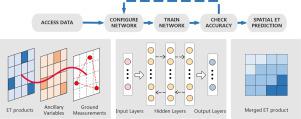Agricultural and Forest Meteorology ( IF 6.2 ) Pub Date : 2021-08-11 , DOI: 10.1016/j.agrformet.2021.108582 Ke Shang 1 , Yunjun Yao 1 , Shunlin Liang 2 , Yuhu Zhang 3 , Joshua B. Fisher 4 , Jiquan Chen 5 , Shaomin Liu 6 , Ziwei Xu 6 , Yuan Zhang 6 , Kun Jia 1 , Xiaotong Zhang 1 , Junming Yang 1 , Xiangyi Bei 1 , Xiaozheng Guo 1 , Ruiyang Yu 1 , Zijing Xie 1 , Lilin Zhang 7

|
Accurate estimates of the spatiotemporal distribution of evapotranspiration (ET) are essential for understanding terrestrial energy, carbon and water cycles. Station-based observations are limited for their spatial coverage whereas satellite-derived ET products exhibit large discrepancies and uncertainties. Here we presented a Deep Neural Networks based Merging ET (DNN-MET) framework that combines information from satellite-derived ET products, eddy covariance (EC) observations and ancillary surface properties to improve the representation of the spatiotemporal distribution of ET, especially in data-sparse regions. DNN-MET was implemented over the Heihe River Basin (HRB) from 2008 to 2015, and the performance of DNN-MET and eight input state-of-the-art satellite-derived ET products (i.e., MOD16, ET-SEMI, ET-JPL, ET-MS, ET-HF, GLEAM, ETMonitor and EB-ET) was evaluated against observations from 19 EC flux tower sites. The results showed that DNN-MET improved ET estimates over HRB, and decreased the RMSE by 0.13 to 1.02 mm/day (14%-56%) when compared with eight products. DNN-MET also yielded superior performance compared to the products derived by other merging methods (i.e., Random Forest, Bayesian model averaging and a simple averaging method). When DNN-MET was validated for data-scarce regions, its performance remained better even when the training samples were decreased to 20% of the available EC sites. An innovation of our approach is by building a multivariate merging model with ancillary surface properties, DNN-MET incorporated geographical proximity effects and spatial autocorrelations into merging procedure, which can be used as a “spatial knowledge engine” to improve ET predictions. The approach can be readily and effectively applied elsewhere to improve the spatiotemporal representation of various hydrometeorological variables.
中文翻译:

DNN-MET:一种深度神经网络方法,用于整合卫星衍生的蒸散产物、涡度协方差观测和辅助信息
准确估计蒸散量 (ET) 的时空分布对于理解陆地能量、碳和水循环至关重要。站基观测的空间覆盖范围有限,而卫星衍生的 ET 产品则表现出很大的差异和不确定性。在这里,我们提出了一个基于深度神经网络的合并 ET (DNN-MET) 框架,该框架结合了来自卫星衍生的 ET 产品、涡流协方差 (EC) 观测和辅助表面特性的信息,以改进 ET 时空分布的表示,尤其是在数据中- 稀疏区域。DNN-MET 于 2008 年至 2015 年在黑河流域(HRB)上实施,DNN-MET 和 8 个输入的最先进卫星衍生 ET 产品(即 MOD16、ET-SEMI、ET -喷气推进实验室、ET-MS、ET-HF、GLEAM、ETMonitor 和 EB-ET)根据来自 19 个 EC 通量塔站点的观察结果进行评估。结果表明,与 8 种产品相比,DNN-MET 比 HRB 提高了 ET 估计值,并将 RMSE 降低了 0.13 至 1.02 毫米/天(14%-56%)。与通过其他合并方法(即随机森林、贝叶斯模型平均和简单平均方法)得出的产品相比,DNN-MET 还产生了卓越的性能。当 DNN-MET 被验证用于数据稀缺区域时,即使训练样本减少到可用 EC 站点的 20%,其性能仍然更好。我们方法的一个创新是通过构建具有辅助表面特性的多元合并模型,DNN-MET 将地理邻近效应和空间自相关性纳入合并过程,它可以用作“空间知识引擎”来改进 ET 预测。该方法可以轻松有效地应用于其他地方,以改善各种水文气象变量的时空表示。

























 京公网安备 11010802027423号
京公网安备 11010802027423号